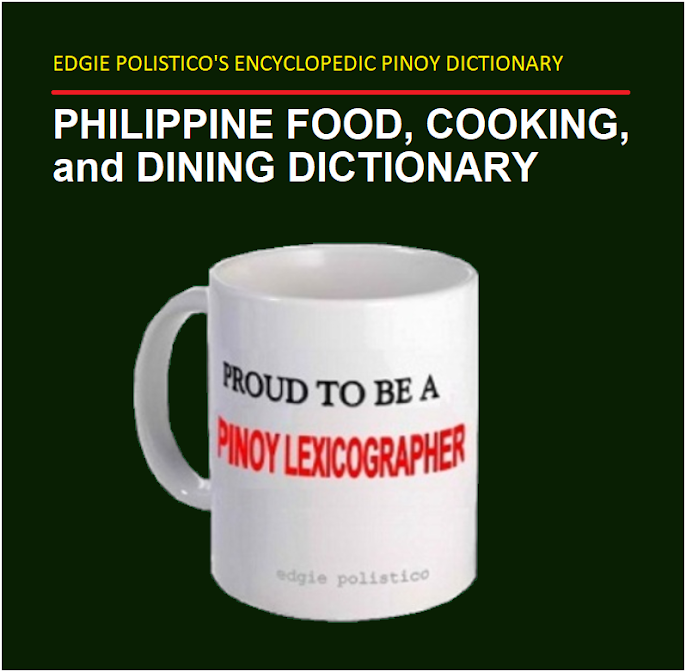.jpg)
martillos - /mar-til-yos/ (Zamboangueño [Chavacano] wafer) [n.] hammer-molded wafer.
A delicate disc wafer embossed with design and curled into a tube.
The wafer is made with flattened flour dough that is then pressed on a wooden mold and hammered with a
mallet to mold the dough with an embossed decorative design. Thus, it is called martillos from the Spanish martillo,
which means “hammer.” The wooden mold is carved with a decorative design
that makes the mold look like that of the Capampangan pan de San Nicolas
biscuit embossed with a design on its surface. The molded dough is trimmed into circular or disc shape and rolled on a metallic tube and deep-fried until it is browned and became a tubular crisp wafer. The wafer looks closely similar to that of rolled Norwegian krumkake and to Italian pizzelle if unrolled or flat, only that martillos is more like a sweet wafer, and delicately crisp.
.jpg) |
Some of the martillos I bought from a stall nearby the Fort Pilar in Zamboanga City |
Martillos
tastes much like a sugary ice cone wafer and can be eaten as is or used to scoop ice
cream or as a wafer for a taco or burrito.
Most vendors selling martillos across Fort Pilar could hardly tell how this curled wafer was originally produced. Nowadays, they don't know it is called martillos. They simply called it apa (wafer) and mistook it as another version of barquillos (wafer roll).
The modern process of making martillos no longer requires the tapping of the mallet (wooden hammer), rather the flour dough is pressed repeatedly with a rolling pin forming into a thin sheet, then pressed on a wooden mold with the rolling pin for the embossed design, and cut into discs and then wrapped around on a wooden or metallic tube and deep fried in electric fryer until crisp and golden brown. This explains why martillos are in uniform design, shape, size, and the way it is curled.
It is so delicate that it would brittle easily and be difficult to bring as pasalubong (bring home gift) without breaking a few pieces of it along the way.
.jpg) |
A pile of martillos on display along with the colored candles for sale to locals, tourists, visitors, and devotees of Fort Pilar in Zamboanga City. |
.jpg) |
Some of the martillos I bought from a stall nearby the Fort Pilar in Zamboanga City
The embossed design is attributed to the al fresco shrine of Fort Pilar with an altar embossed with sculptures on the massive wall of this unique open space church of Zamboanga City
.jpg) |
The roofless shrine of Fort Pilar in Zamboanga City where the Holy Mass is regularly celebrated everyday.
|
.jpg) |
My first visit to the altar of the Shrine of Fort Pilar in Zamboanga City. Behind me is the main altar with embossed sculptures on its massive stone wall. |
If you liked this post and our site, share it.
Let us know your opinion on the subject. Feel free to comment in the comment section, below. It is important for us to know what you think.
Tell us what other topics you would like us to write, share, and discuss about.
For more about Filipino food, see this Philippine Food, Cooking, and Dining Dictionary. It is OPEN and FREE.
Continue to follow my blogs. You can also follow and learn more by joining us in our Facebook group. Have more bits and pieces about our kind of food, ingredients, and ways of cooking, dining, and knowing food culture across the 7,641 islands of the Philippines.
Encouragement and enthusiasm are not enough. I also need moral support, prayers, and anything else that can uplift my spirit and keep my good reasons. Keep them coming. All I know is that I am happy with what I am sharing and giving away. If you are pleased and happy with what I am doing, just smile and please share the happiness. Keep sharing and include to share the PHILIPPINE FOOD ILLUSTRATED. I feel energized when my blog becomes one of the reasons why you are happy and smiling.
Edgie Polistico
.jpg)

.jpg)

.jpg)
.jpg)
.jpg)
.jpg)
.jpg)
.jpg)


.jpg)
.jpg)
.jpg)
.jpg)
.JPG)
.jpg)

.jpg)
.jpg)




